Evaluating the Effectiveness of Best Management Practices in Adapting the Impacts of Climate Change-Induced Urban Flooding
Abstract
:1. Introduction
2. Site Description and Data
2.1. Study Area
2.2. Watershed Characteristics
2.3. NARCCAP Climate Model
2.4. NCEP North American Regional Reanalysis (NARR)
3. Methodology
3.1. Design Depth
3.2. Hydrologic Modeling
3.3. BMP Installation
4. Results and Discussions
4.1. Verification of NARCCAP-Generated Storm Depths
4.2. Streamflow Variability Due to Climate Change
4.3. Performance of Best Management Practices on Climate Change Scenarios
5. Conclusions
- The projected 6 h 100-year return period precipitation storm for the East St. Louis watershed is expected to increase by at least 1.06 (determined by Timeslice CCSM) up to a maximum of 1.75 (determined from HADCM3-HRM3). This result highlights the uncertainty in the NARCCAP model’s climate change predictions for the East St. Louis watershed.
- The hydrological simulation revealed that peak discharge ranges would increase by 5% to 43%, and flood volume ranges would increase by 8% to 94% for different NARCCAP-generated future climate change scenarios. Furthermore, the results demonstrate that an increase in flood volume indicates the severity of climate change compared to a peak discharge increase.
- The Best Management Practices (BMPs) were effective in reducing peak discharge and flood volumes for all climate change scenarios. However, their performance varies with the severity of the climate change event. The results indicate that BMP effectiveness decreases as the severity of extreme flooding events increases. Infiltration trenches provide the most significant flood reduction benefit for all climate scenarios, while Permeable Pavement consistently demonstrates benefits for all four climate scenarios. However, green roof implementation provided the least benefit in flood mitigation, with negligible peak discharge reduction for the most severe climate change events. The average peak discharge reduction performance of the green roof, infiltration trenches, and Permeable Pavement was 4%, 13%, and 12%, respectively. Similarly, the average flood volume reduction performance of the green roof, infiltration trenches, and Permeable Pavement was 14%, 28%, and 12%, respectively.
Author Contributions
Funding
Institutional Review Board Statement
Informed Consent Statement
Data Availability Statement
Acknowledgments
Conflicts of Interest
References
- Ranasinghe, R.; Ruane, A.C.; Vautard, R. Intergovernmental Panel on Climate Change Climate Change 2021—The Physical Science Basis: Working Group I Contribution to the Sixth Assessment Report of the Intergovernmental Panel on Climate Change, 1st ed.; Cambridge University Press: Cambridge, UK, 2023; ISBN 978-1-00-915789-6. [Google Scholar]
- Brazil—80 Killed in Floods and Landslides in North East—FloodList. Available online: https://floodlist.com/america/brazil-floods-update-pernambuco-alagoas-may-2022 (accessed on 2 December 2023).
- India—Heavy Rain and Floods in Gujarat Affect over 1 Million—FloodList. Available online: https://floodlist.com/asia/india-floods-gujarat-july-2022 (accessed on 2 December 2023).
- China Flooding: Death Toll Rises in Henan as Passengers Recount Horror of Zhengzhou Subway Floods|CNN. Available online: https://www.cnn.com/2021/07/22/china/zhengzhou-henan-china-flooding-update-intl-hnk/index.html (accessed on 2 December 2023).
- Mackenzie, A.A. James Deadly Floods in China, Europe Send Stark Reminder of Climate Change Vulnerabilities. Available online: https://www.insurancejournal.com/news/international/2021/07/22/623788.htm (accessed on 2 December 2023).
- Billion-Dollar Weather and Climate Disasters| National Centers for Environmental Information (NCEI). Available online: https://www.ncei.noaa.gov/access/billions/ (accessed on 19 February 2024).
- Alfieri, L.; Bisselink, B.; Dottori, F.; Naumann, G.; de Roo, A.; Salamon, P.; Wyser, K.; Feyen, L. Global projections of river flood risk in a warmer world. Earth’s Future 2017, 5, 171–182. [Google Scholar] [CrossRef]
- Arnell, N.W.; Gosling, S.N. The impacts of climate change on river flood risk at the global scale. Clim. Chang. 2016, 134, 387–401. [Google Scholar] [CrossRef]
- Wu, X.; Wang, Z.; Guo, S.; Liao, W.; Zeng, Z.; Chen, X. Scenario-based projections of future urban inundation within a coupled hydrodynamic model framework: A case study in Dongguan City, China. J. Hydrol. 2017, 547, 428–442. [Google Scholar] [CrossRef]
- Mahmood, M.I.; Elagib, N.A.; Horn, F.; Saad, S.A. Lessons learned from Khartoum flash flood impacts: An integrated assessment. Sci. Total Environ. 2017, 601–602, 1031–1045. [Google Scholar] [CrossRef]
- Acharya, B.; Joshi, B. Flood frequency analysis for an ungauged Himalayan river basin using different methods: A case study of Modi Khola, Parbat, Nepal. Meteorol. Hydrol. Water Manag. Res. Oper. Appl. 2020, 8, 46–51. [Google Scholar] [CrossRef]
- Banjara, M.; Bhusal, A.; Ghimire, A.B.; Kalra, A. Impact of Land Use and Land Cover Change on Hydrological Processes in Urban Watersheds: Analysis and Forecasting for Flood Risk Management. Geosciences 2024, 14, 40. [Google Scholar] [CrossRef]
- Mahmoud, S.H.; Gan, T.Y. Urbanization and climate change implications in flood risk management: Developing an efficient decision support system for flood susceptibility mapping. Sci. Total Environ. 2018, 636, 152–167. [Google Scholar] [CrossRef]
- Ahiablame, L.; Shakya, R. Modeling flood reduction effects of low impact development at a watershed scale. J. Environ. Manag. 2016, 171, 81–91. [Google Scholar] [CrossRef] [PubMed]
- Eckart, K.; McPhee, Z.; Bolisetti, T. Performance and implementation of low impact development––A review. Sci. Total Environ. 2017, 607–608, 413–432. [Google Scholar] [CrossRef]
- Ristianti, N.S.; Bashit, N.; Ulfiana, D.; Windarto, Y.E. Bioretention Basin, Rain Garden, and Swales Track Concepts through Vegetated-WSUD: Sustainable Rural Stormwater Management in Klaten Regency. IOP Conf. Ser. Earth Environ. Sci. 2022, 1082, 012029. [Google Scholar] [CrossRef]
- Liu, Y.; Engel, B.A.; Flanagan, D.C.; Gitau, M.W.; McMillan, S.K.; Chaubey, I. A review on effectiveness of best management practices in improving hydrology and water quality: Needs and opportunities. Sci. Total Environ. 2017, 601–602, 580–593. [Google Scholar] [CrossRef]
- Ercolani, G.; Chiaradia, E.A.; Gandolfi, C.; Castelli, F.; Masseroni, D. Evaluating performances of green roofs for stormwater runoff mitigation in a high flood risk urban catchment. J. Hydrol. 2018, 566, 830–845. [Google Scholar] [CrossRef]
- Azis, S.S.A.; Zulkifli, N.A.A. Green roof for sustainable urban flash flood control via cost benefit approach for local authority. Urban For. Urban Green. 2021, 57, 126876. [Google Scholar] [CrossRef]
- Zhang, L.; Oyake, Y.; Morimoto, Y.; Niwa, H.; Shibata, S. Rainwater storage/infiltration function of rain gardens for management of urban storm runoff in Japan. Landsc. Ecol. Eng. 2019, 15, 421–435. [Google Scholar] [CrossRef]
- de Macedo, M.B.; Lago, C.A.F.D.; Mendiondo, E.M.; Giacomoni, M.H. Bioretention performance under different rainfall regimes in subtropical conditions: A case study in São Carlos, Brazil. J. Environ. Manag. 2019, 248, 109266. [Google Scholar] [CrossRef]
- Hu, M.; Zhang, X.; Siu, Y.L.; Li, Y.; Tanaka, K.; Yang, H.; Xu, Y. Flood Mitigation by Permeable Pavements in Chinese Sponge City Construction. Water 2018, 10, 172. [Google Scholar] [CrossRef]
- Rodríguez-Rojas, M.; Huertas-Fernández, F.; Moreno, B.; Martínez, G.; Grindlay, A. A study of the application of permeable pavements as a sustainable technique for the mitigation of soil sealing in cities: A case study in the south of Spain. J. Environ. Manag. 2018, 205, 151–162. [Google Scholar] [CrossRef]
- Kumar, S.; Guntu, R.K.; Agarwal, A.; Villuri, V.G.K.; Pasupuleti, S.; Kaushal, D.R.; Gosian, A.K.; Bronstert, A. Multi-objective optimization for stormwater management by green-roofs and infiltration trenches to reduce urban flooding in central Delhi. J. Hydrol. 2022, 606, 127455. [Google Scholar] [CrossRef]
- Jamali, B.; Bach, P.M.; Deletic, A. Rainwater harvesting for urban flood management—An integrated modelling framework. Water Res. 2020, 171, 115372. [Google Scholar] [CrossRef]
- Tamagnone, P.; Comino, E.; Rosso, M. Rainwater harvesting techniques as an adaptation strategy for flood mitigation. J. Hydrol. 2020, 586, 124880. [Google Scholar] [CrossRef]
- Oberascher, M.; Kinzel, C.; Kastlunger, U.; Kleidorfer, M.; Zingerle, C.; Rauch, W.; Sitzenfrei, R. Integrated urban water management with micro storages developed as an IoT-based solution—The smart rain barrel. Environ. Model. Softw. 2021, 139, 105028. [Google Scholar] [CrossRef]
- Khazaei, M.R.; Zahabiyoun, B.; Saghafian, B. Assessment of climate change impact on floods using weather generator and continuous rainfall-runoff model. Int. J. Clim. 2012, 32, 1997–2006. [Google Scholar] [CrossRef]
- Koop, S.H.A.; Van Leeuwen, C.J. The challenges of water, waste and climate change in cities. Environ. Dev. Sustain. 2017, 19, 385–418. [Google Scholar] [CrossRef]
- Mearns, L.O.; Sain, S.; Leung, L.R.; Bukovsky, M.S.; McGinnis, S.; Biner, S.; Caya, D.; Arritt, R.W.; Gutowski, W.; Takle, E.; et al. Climate change projections of the North American Regional Climate Change Assessment Program (NARCCAP). Clim. Chang. 2013, 120, 965–975. [Google Scholar] [CrossRef]
- Mearns, L.O.; Lettenmaier, D.P.; McGinnis, S. Uses of Results of Regional Climate Model Experiments for Impacts and Adaptation Studies: The Example of NARCCAP. Curr. Clim. Chang. Rep. 2015, 1, 1–9. [Google Scholar] [CrossRef]
- Mailhot, A.; Duchesne, S.; Caya, D.; Talbot, G. Assessment of future change in intensity–duration–frequency (IDF) curves for Southern Quebec using the Canadian Regional Climate Model (CRCM). J. Hydrol. 2007, 347, 197–210. [Google Scholar] [CrossRef]
- Diaz-Nieto, J.; Wilby, R.L. A comparison of statistical downscaling and climate change factor methods: Impacts on low flows in the River Thames, United Kingdom. Clim. Chang. 2005, 69, 245–268. [Google Scholar] [CrossRef]
- Kousky, C.; Kunreuther, H. Improving Flood Insurance and Flood-Risk Management: Insights from St. Louis, Missouri. Nat. Hazards Rev. 2010, 11, 162–172. [Google Scholar] [CrossRef]
- Thakali, R.; Kalra, A.; Ahmad, S. Understanding the Effects of Climate Change on Urban Stormwater Infrastructures in the Las Vegas Valley. Hydrology 2016, 3, 34. [Google Scholar] [CrossRef]
- Mesinger, F.; DiMego, G.; Kalnay, E.; Mitchell, K.; Shafran, P.C.; Ebisuzaki, W.; Jović, D.; Woollen, J.; Rogers, E.; Berbery, E.H.; et al. North American Regional Reanalysis. Bull. Am. Meteorol. Soc. 2006, 87, 343–360. [Google Scholar] [CrossRef]
- Baek, S.-S.; Ligaray, M.; Pyo, J.; Park, J.-P.; Kang, J.-H.; Pachepsky, Y.; Chun, J.A.; Cho, K.H. A novel water quality module of the SWMM model for assessing low impact development (LID) in urban watersheds. J. Hydrol. 2020, 586, 124886. [Google Scholar] [CrossRef]
- Bhusal, A.; Ghimire, A.B.; Thakur, B.; Kalra, A. Evaluating the hydrological performance of integrating PCSWMM and NEXRAD precipitation product at different spatial scales of watersheds. Model. Earth Syst. Environ. 2023, 9, 4251–4264. [Google Scholar] [CrossRef]
- Ahiablame, L.; Engel, B.A.; Chaubey, I. Representation and Evaluation of Low Impact Development Practices with L-THIA-LID: An Example for Site Planning. Environ. Pollut. 2012, 1, p1. [Google Scholar] [CrossRef]
- Arora, M.; Chopra, I.; Nguyen, M.H.; Fernando, P.; Burns, M.J.; Fletcher, T.D. Flood Mitigation Performance of Permeable Pavements in an Urbanised Catchment in Melbourne, Australia (Elizabeth Street Catchment): Case Study. Water 2023, 15, 562. [Google Scholar] [CrossRef]
- Iqbal, A.; Rahman, M.; Beecham, S. Permeable Pavements for Flood Control in Australia: Spatial Analysis of Pavement Design Considering Rainfall and Soil Data. Sustainability 2022, 14, 4970. [Google Scholar] [CrossRef]
- Petit-Boix, A.; Sevigné-Itoiz, E.; Rojas-Gutierrez, L.A.; Barbassa, A.P.; Josa, A.; Rieradevall, J.; Gabarrell, X. Environmental and economic assessment of a pilot stormwater infiltration system for flood prevention in Brazil. Ecol. Eng. 2015, 84, 194–201. [Google Scholar] [CrossRef]
- Liu, L.; Sun, L.; Niu, J.; Riley, W.J. Modeling Green Roof Potential to Mitigate Urban Flooding in a Chinese City. Water 2020, 12, 2082. [Google Scholar] [CrossRef]
- Liu, W.; Chen, W.; Peng, C. Assessing the effectiveness of green infrastructures on urban flooding reduction: A community scale study. Ecol. Model. 2014, 291, 6–14. [Google Scholar] [CrossRef]
- Nyaupane, N.; Thakali, R.; Kalra, A.; Mastino, L.; Velotta, M.; Ahmad, S. Response of Climate Change on Urban Watersheds: A Case Study for Las Vegas, NV. In Proceedings of the World Environmental and Water Resources Congress 2017, Sacramento, CA, USA, 21–25 May 2017; pp. 485–496. [Google Scholar]
- Nyaupane, N.; Mote, S.R.; Bhandari, M.; Kalra, A.; Ahmad, S. Rainfall-runoff simulation using climate change based precipitation prediction in HEC-HMS model for Irwin Creek, Charlotte, North Carolina. In Proceedings of the World Environmental and Water Resources Congress 2018, Minneapolis, MN, USA, 3–7 June 2018; American Society of Civil Engineers: Reston, VA, USA, 2018; pp. 352–363. [Google Scholar]
- Thakali, R.; Kalra, A.; Ahmad, S.; Qaiser, K. Management of an Urban Stormwater System Using Projected Future Scenarios of Climate Models: A Watershed-Based Modeling Approach. Open Water 2018, 5, 1. [Google Scholar]
- Hettiarachchi, S.; Wasko, C.; Sharma, A. Increase in flood risk resulting from climate change in a developed urban watershed—The role of storm temporal patterns. Hydrol. Earth Syst. Sci. 2018, 22, 2041–2056. [Google Scholar] [CrossRef]
- Zhu, J.; Stone, M.C.; Forsee, W. Analysis of potential impacts of climate change on intensity–duration–frequency (IDF) relationships for six regions in the United States. J. Water Clim. Chang. 2012, 3, 185–196. [Google Scholar] [CrossRef]
- Ionno, A.; Arsenault, R.; Troin, M.; Martel, J.-L.; Brissette, F. Impacts of climate change on flood volumes over North American catchments. J. Hydrol. 2024, 630, 130688. [Google Scholar] [CrossRef]
- Swain, D.L.; Wing, O.E.J.; Bates, P.D.; Done, J.M.; Johnson, K.A.; Cameron, D.R. Increased Flood Exposure Due to Climate Change and Population Growth in the United States. Earth’s Future 2020, 8, e2020EF001778. [Google Scholar] [CrossRef]
- Klein, C.; Jackson, L.S.; Parker, D.J.; Marsham, J.H.; Taylor, C.M.; Rowell, D.P.; Guichard, F.; Vischel, T.; Famien, A.M.L.; Diedhiou, A. Combining CMIP data with a regional convection-permitting model and observations to project extreme rainfall under climate change. Environ. Res. Lett. 2021, 16, 104023. [Google Scholar] [CrossRef]
- Pal, S.C.; Chowdhuri, I.; Das, B.; Chakrabortty, R.; Roy, P.; Saha, A.; Shit, M. Threats of climate change and land use patterns enhance the susceptibility of future floods in India. J. Environ. Manag. 2022, 305, 114317. [Google Scholar] [CrossRef] [PubMed]
- Tabari, H. Climate change impact on flood and extreme precipitation increases with water availability. Sci. Rep. 2020, 10, 13768. [Google Scholar] [CrossRef] [PubMed]
- Hua, P.; Yang, W.; Qi, X.; Jiang, S.; Xie, J.; Gu, X.; Li, H.; Zhang, J.; Krebs, P. Evaluating the effect of urban flooding reduction strategies in response to design rainfall and low impact development. J. Clean. Prod. 2020, 242, 118515. [Google Scholar] [CrossRef]
- Kourtis, I.M.; Tsihrintzis, V.A.; Baltas, E. A robust approach for comparing conventional and sustainable flood mitigation measures in urban basins. J. Environ. Manag. 2020, 269, 110822. [Google Scholar] [CrossRef]
- Yang, W.; Zhang, J.; Krebs, P. Low impact development practices mitigate urban flooding and non-point pollution under climate change. J. Clean. Prod. 2022, 347, 131320. [Google Scholar] [CrossRef]
- He, L.; Li, S.; Cui, C.-H.; Yang, S.-S.; Ding, J.; Wang, G.-Y.; Bai, S.-W.; Zhao, L.; Cao, G.-L.; Ren, N.-Q. Runoff control simulation and comprehensive benefit evaluation of low-impact development strategies in a typical cold climate area. Environ. Res. 2022, 206, 112630. [Google Scholar] [CrossRef]
- Lewellyn, C.; Lyons, C.E.; Traver, R.G.; Wadzuk, B.M. Evaluation of Seasonal and Large Storm Runoff Volume Capture of an Infiltration Green Infrastructure System. J. Hydrol. Eng. 2016, 21, 04015047. [Google Scholar] [CrossRef]
- Masseroni, D.; Cislaghi, A. Green roof benefits for reducing flood risk at the catchment scale. Environ. Earth Sci. 2016, 75, 579. [Google Scholar] [CrossRef]
- Meena, Y.R.; Gupta, A.K. Spatial BMP approach for mitigating the urban flooding in Bengaluru city, Karnataka, India. Spat. Inf. Res. 2018, 26, 527–536. [Google Scholar] [CrossRef]
- Qiu, J.; Shen, Z.; Hou, X.; Xie, H.; Leng, G. Evaluating the Performance of Conservation Practices under Climate Change Scenarios in the Miyun Reservoir Watershed, China. Ecol. Eng. 2020, 143, 105700. [Google Scholar] [CrossRef]
- Dudula, J.; Randhir, T.O. Modeling the influence of climate change on watershed systems: Adaptation through targeted practices. J. Hydrol. 2016, 541, 703–713. [Google Scholar] [CrossRef]
- Giri, S.; Lathrop, R.G.; Obropta, C.C. Climate change vulnerability assessment and adaptation strategies through best management practices. J. Hydrol. 2020, 580, 124311. [Google Scholar] [CrossRef]
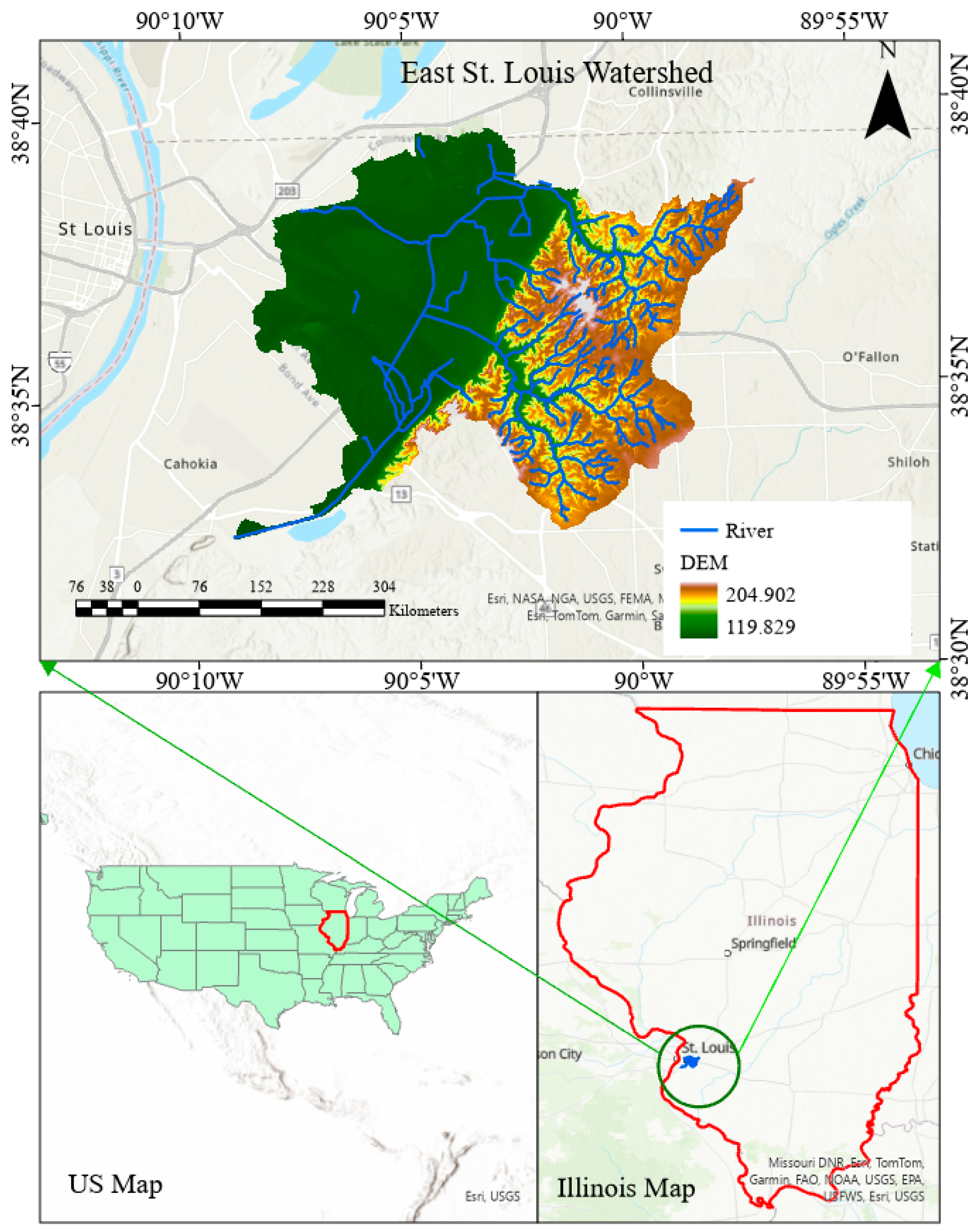
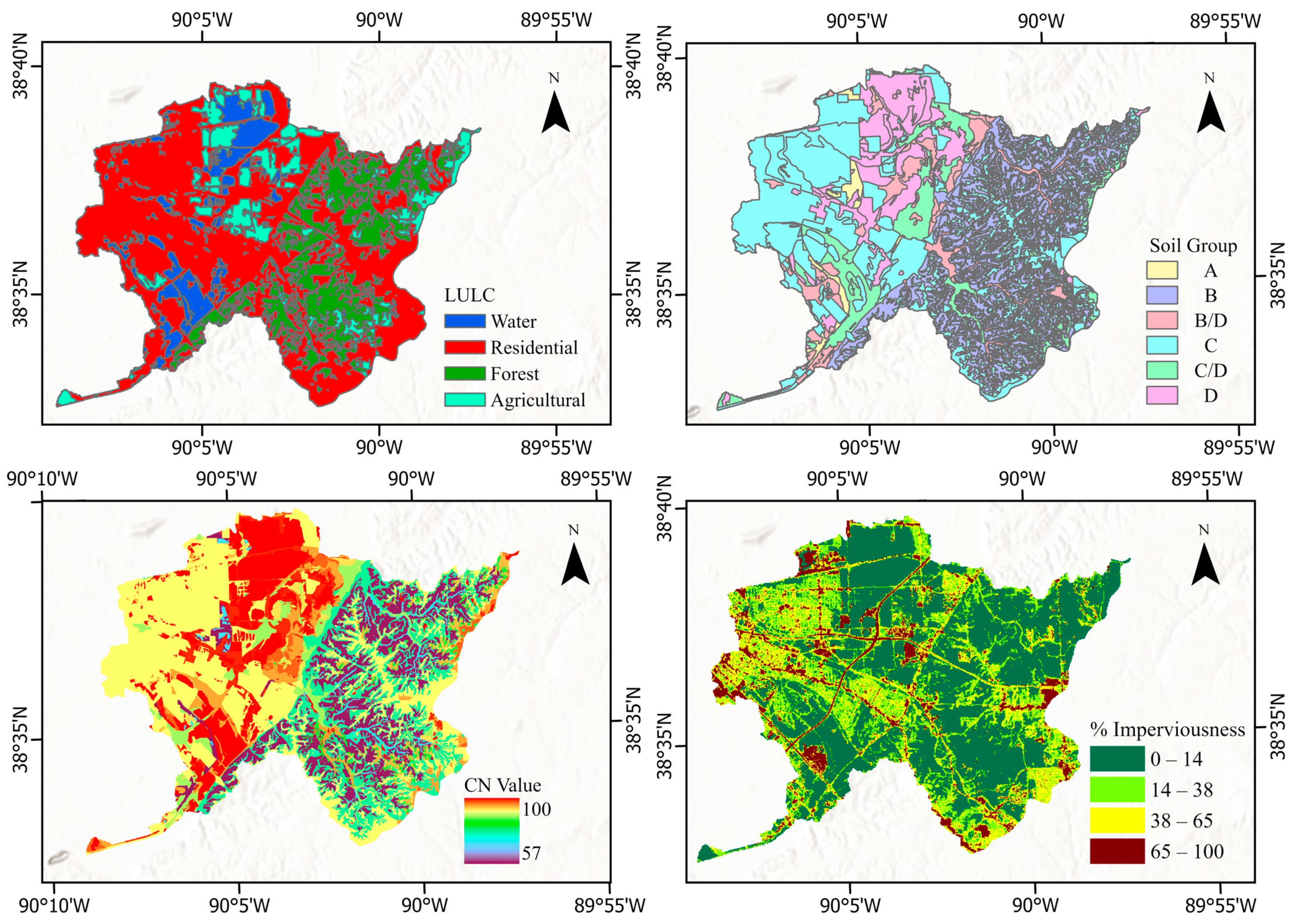


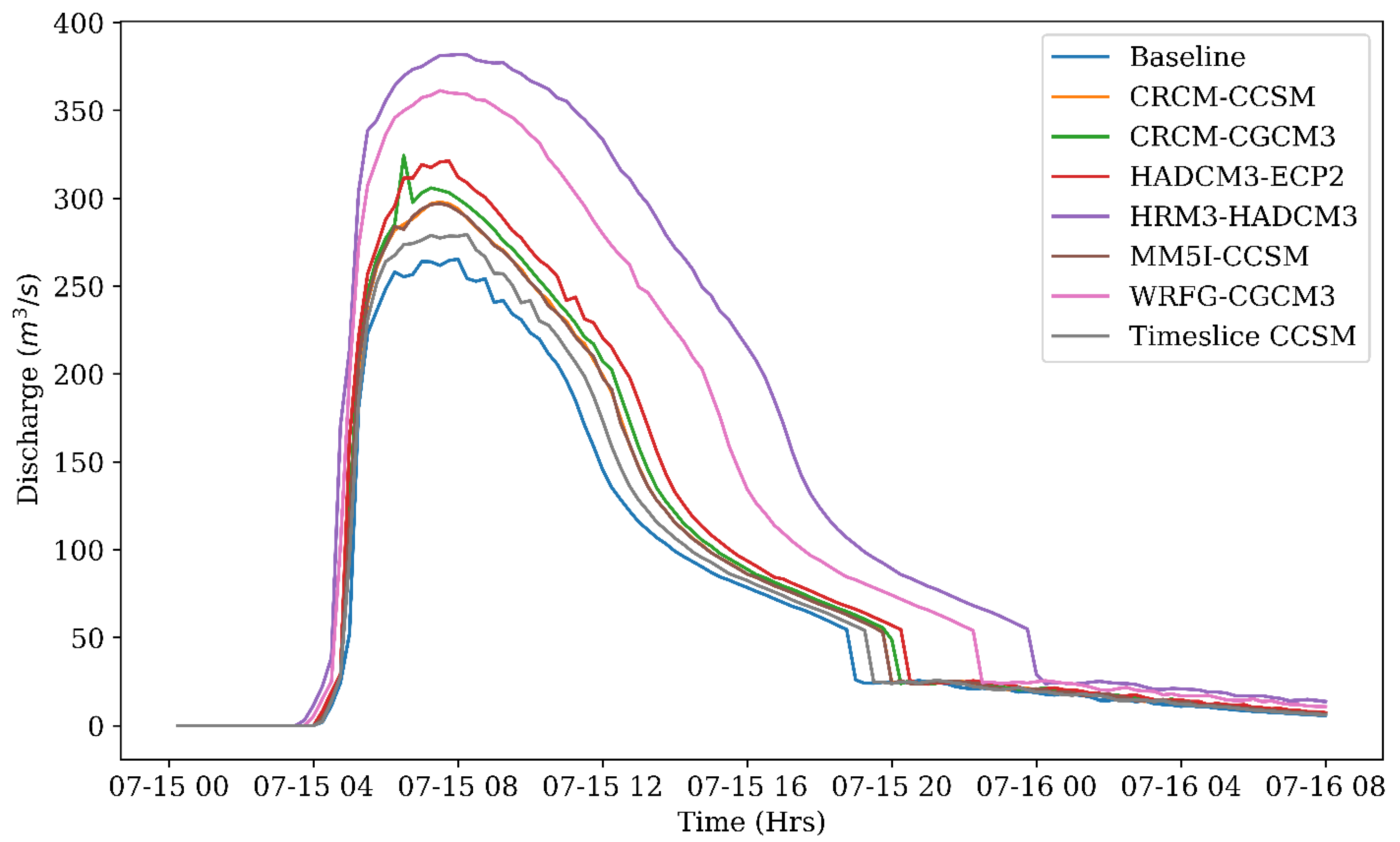
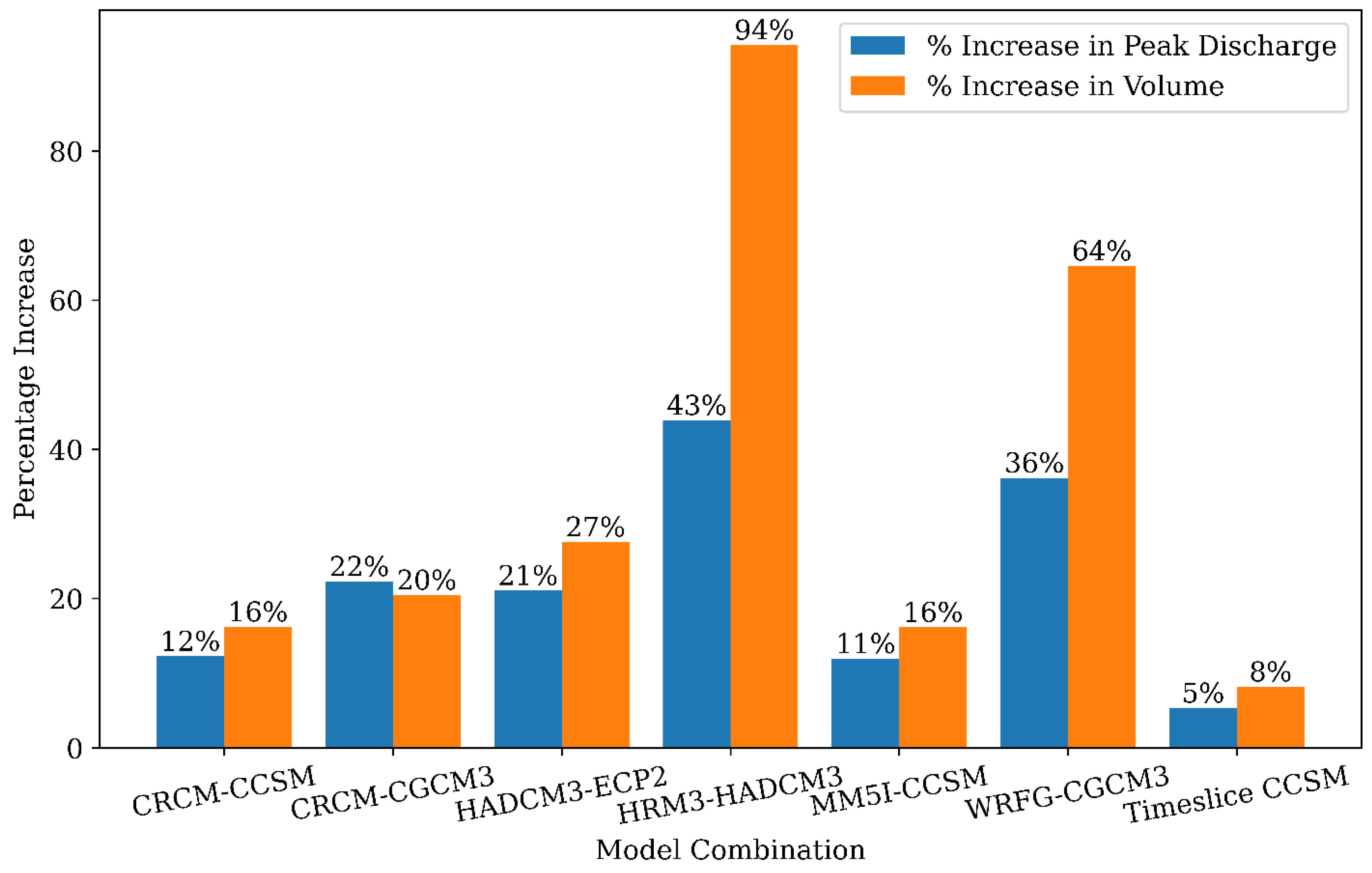
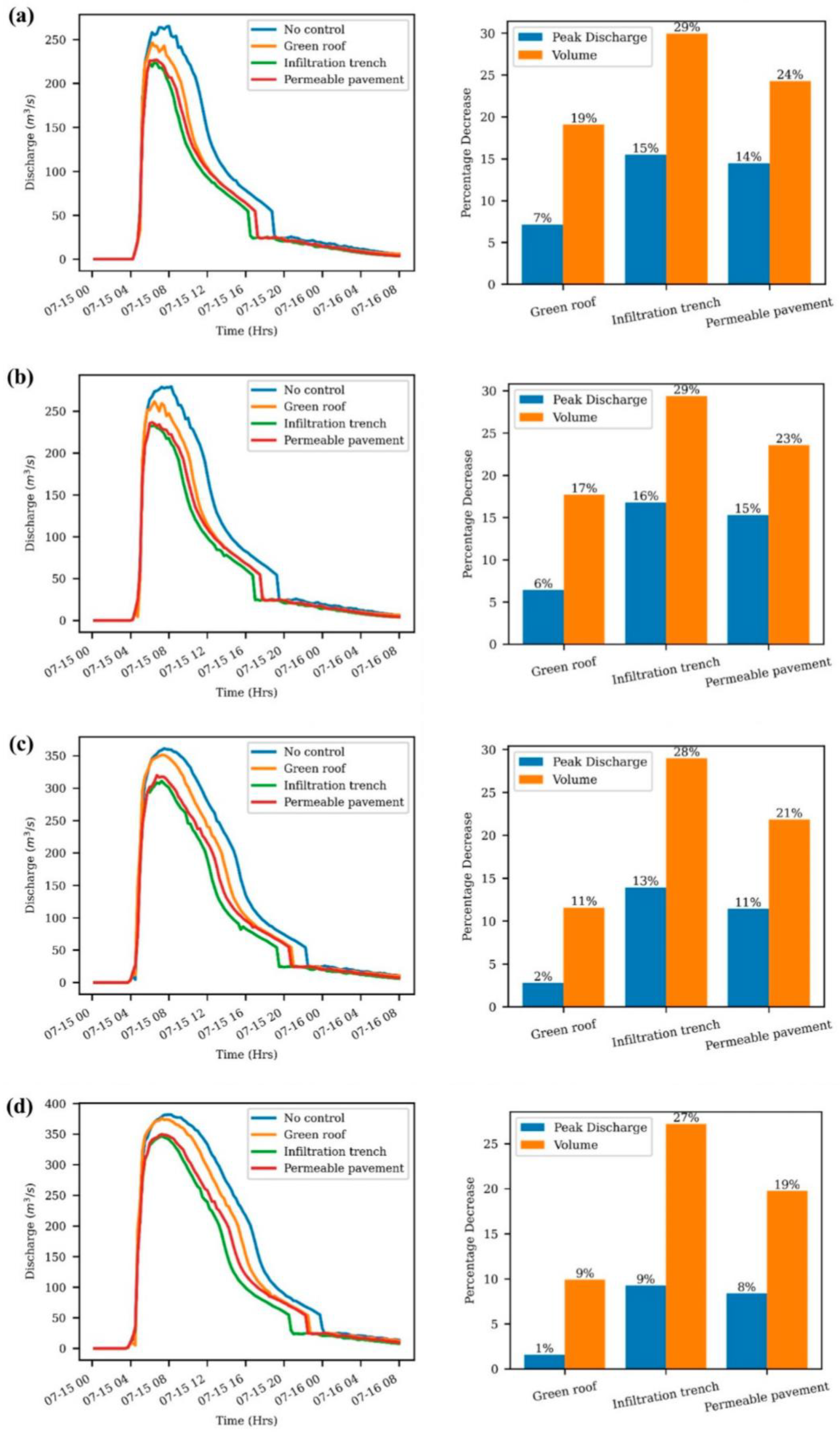
| Regional Climate Model | Global Climate Model | |||
|---|---|---|---|---|
| CCSM | CGCM3 | GFDL | HadCM3 | |
| CRCM | CRCM-CCSM | CRCM-CGCM3 | - | - |
| ECP2 | - | - | ECP2-GFDL | ECP2-HADCM3 |
| HRM3 | - | - | HRM3-GFDL | HRM3-HADCM3 |
| MM5I | MM5I-CCSM | - | - | MM5I-HADCM3 |
| RCM3 | - | RCM3-CGCM3 | RCM3-GFDL | - |
| WRFG | WRFG-CCSM | WRFG-CGCM3 | - | - |
| Timeslice | Timeslice CCSM | - | Timeslice GFDL | - |
| Layers | Parameter | Permeable Pavement | Green Roof | Infiltration Trench | Unit |
|---|---|---|---|---|---|
| Surface | Berm height | 100 | 100 | 100 | mm |
| Vegetation Volume | 0.1 | 0.1 | 0.1 | fraction | |
| Pavement | Thickness | 150 | N/A | N/A | mm |
| Void ratio | 0.21 | N/A | N/A | ||
| Permeability | 2000 | N/A | N/A | mm/h | |
| Clogging factor | 83 | N/A | N/A | ||
| Soil | Thickness | 100 | 100 | N/A | mm |
| Porosity | 0.5 | 0.5 | N/A | ||
| Field Capacity | 0.2 | 0.2 | N/A | ||
| Wilting Point | 0.1 | 0.1 | N/A | ||
| Conductivity | 0.5 | 0.5 | N/A | mm/h | |
| Conductivity Slope | 30 | 30 | N/A | ||
| Suction head | 3.5 | 3.5 | N/A | mm | |
| Storage | Thickness | 300 | N/A | 300 | mm |
| Void ratio | 0.75 | N/A | 0.75 | ||
| Seepage rate | 0.5 | N/A | 0.5 | mm/h | |
| Underdrain | Drain coefficient | 0.2 | N/A | 0.2 | mm/h |
| Drain exponent | 0.5 | N/A | 0.5 | ||
| Drain offset height | 30 | N/A | 30 | mm | |
| Drainage Material | Thickness | N/A | 25.4 | N/A | mm |
| Void fraction | N/A | 0.5 | N/A | ||
| Roughness | N/A | 0.2 | N/A |
Disclaimer/Publisher’s Note: The statements, opinions and data contained in all publications are solely those of the individual author(s) and contributor(s) and not of MDPI and/or the editor(s). MDPI and/or the editor(s) disclaim responsibility for any injury to people or property resulting from any ideas, methods, instructions or products referred to in the content. |
© 2024 by the authors. Licensee MDPI, Basel, Switzerland. This article is an open access article distributed under the terms and conditions of the Creative Commons Attribution (CC BY) license (https://creativecommons.org/licenses/by/4.0/).
Share and Cite
Bhusal, A.; Thakur, B.; Kalra, A.; Benjankar, R.; Shrestha, A. Evaluating the Effectiveness of Best Management Practices in Adapting the Impacts of Climate Change-Induced Urban Flooding. Atmosphere 2024, 15, 281. https://doi.org/10.3390/atmos15030281
Bhusal A, Thakur B, Kalra A, Benjankar R, Shrestha A. Evaluating the Effectiveness of Best Management Practices in Adapting the Impacts of Climate Change-Induced Urban Flooding. Atmosphere. 2024; 15(3):281. https://doi.org/10.3390/atmos15030281
Chicago/Turabian StyleBhusal, Amrit, Balbhadra Thakur, Ajay Kalra, Rohan Benjankar, and Aruna Shrestha. 2024. "Evaluating the Effectiveness of Best Management Practices in Adapting the Impacts of Climate Change-Induced Urban Flooding" Atmosphere 15, no. 3: 281. https://doi.org/10.3390/atmos15030281







